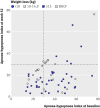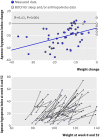Longer term effects of very low energy diet on obstructive sleep apnoea in cohort derived from randomised controlled trial: prospective observational follow-up study
- PMID: 21632666
- PMCID: PMC3106149
- DOI: 10.1136/bmj.d3017
Longer term effects of very low energy diet on obstructive sleep apnoea in cohort derived from randomised controlled trial: prospective observational follow-up study
Abstract
Objective: To determine whether initial improvements in obstructive sleep apnoea after a very low energy diet were maintained after one year in patients with moderate to severe obstructive sleep apnoea.
Design: Single centre, prospective observational follow-up study.
Setting: Outpatient obesity clinic in a university hospital in Stockholm, Sweden.
Participants: 63 men aged 30-65 with body mass index (BMI) 30-40 and moderate to severe obstructive sleep apnoea defined as an apnoea-hypopnoea index ≥ 15 (events/hour), all treated with continuous positive airway pressure.
Intervention: A one year weight loss programme, consisting of an initial very low energy diet for nine weeks (seven weeks of 2.3 MJ/day and two weeks of gradual introduction of normal food) followed by a weight loss maintenance programme.
Main outcome measure: Apnoea-hypopnoea index, the main index for severity of obstructive sleep apnoea. Data from all patients were analysed (baseline carried forward for missing data).
Results: Of 63 eligible patients, 58 completed the very low energy diet period and started the weight maintenance programme and 44 completed the full programme; 49 had complete measurements at one year. At baseline the mean apnoea-hypopnoea index was 36 events/hour. After the very low energy diet period, apnoea-hypopnoea index was improved by -21 events/hour (95% confidence interval -17 to -25) and weight by -18 kg (-16 to -19; both P<0.001). After one year the apnoea-hypopnoea index had improved by -17 events/hour (-13 to -21) and body weight by -12 kg (-10 to -14) compared with baseline (both P<0.001). Patients with severe obstructive sleep apnoea at baseline had greater improvements in apnoea-hypopnoea index (-25 events/hour) compared with patients with moderate disease (-7 events/hour, P<0.001). At one year, 30/63 (48%, 95% confidence interval 35% to 60%) no longer required continuous positive airway pressure and 6/63 (10%, 2% to 17%) had total remission of obstructive sleep apnoea (apnoea-hypopnoea index <5 events/hour). There was a dose-response association between weight loss and apnoea-hypopnoea index at follow-up (β = 0.50 events/kg, 0.11 to 0.88; P = 0.013).
Conclusion: Initial improvements in obstructive sleep apnoea after treatment with a very low energy diet can be maintained after one year in obese men with moderate to severe disease. Those who lose the most weight or have severe sleep apnoea at baseline benefit most. Trial registration Current Controlled Trials 70090382.
Conflict of interest statement
Competing interests: All authors have completed the Unified Competing Interest form at
Figures





Comment in
-
Initial improvements in apnoea-hypopnoea index after very low calorie diet maintained for 1 year with weight loss maintenance program.Evid Based Med. 2012 Feb;17(1):32-3. doi: 10.1136/ebm.2011.100169. Epub 2011 Sep 6. Evid Based Med. 2012. PMID: 21900278 No abstract available.
References
Publication types
MeSH terms
LinkOut - more resources
Full Text Sources
Other Literature Sources
Medical
